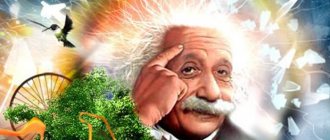The ability to be creative and create something new has always been highly valued in society. And it is not surprising, since people who have this gift are unique generators of the development of human civilization. But creativity also has subjective value. A person endowed with them creates the most comfortable conditions for existence, transforms the world, adapting it to his needs and interests.
It would seem that everything is simple: you need to actively develop these abilities. However, humanity has been struggling for hundreds of years with the question of what is the secret of creativity, what makes a person a creator.
Adjusting the settings: psychological attitudes that will help develop creativity
Before moving on to practical recommendations, I want to pay due attention to psychological settings. Let's talk about how you need to perceive creativity and yourself in it, how to relate to it, what to expect. And at the same time, we’ll dispel some harmful myths about creativity.
Creativity is accessible to everyone
In the minds of some people, stereotypes from 50 years ago still dominate, according to which creativity is the preserve of a select few. Allegedly, a person’s fate is predetermined by genes, physiological characteristics and other immutable prerequisites. And if, for example, a child at the age of 5 does not demonstrate perfect pitch, then the path to becoming a musician is closed to him.
More than 100 cool lessons, tests and exercises for brain development
Start developing
However, this myth has long been dispelled by numerous scientific studies. Scientists loudly declare that creative abilities can and should be developed. And you can do this at any age. Of course, there are people who are naturally endowed with creative inclinations. But these inclinations should be viewed not as an indisputable advantage, but as a small head start.
Imagine that you are going to participate in a marathon. Among the participants there are several people who have a head start. The starting line for them is shifted several tens of meters forward. Will this handicap guarantee victory at the finish line? Of course not. Much more important is the training of athletes, their strong-willed qualities and desire to win.
The situation is the same in any other matter. Perseverance, determination, and self-discipline outweigh natural inclinations. And that's great! This means that a person can completely create himself and confirm the title of the crown of nature.
I suggest reading the article about what motivation is. After all, without this component of personality it is impossible to effectively engage in self-development.
Creativity does not need to be “awakened”
“Awaken creativity” is a fundamentally incorrect and harmful expression. It gives the impression that within every person these abilities already exist and you just need to dig deep within yourself to find them.
This is the same as believing that every person has the ability to read. We know that this is not so. In fact, we only have tools with which we can achieve the development of any skill or ability, including creative abilities. These are our neurons and brain hormones that are responsible for higher nervous activity.
Any skill is a system of neural connections formed in the process of activity. The denser and more branched this system is, the higher the person’s skill in a particular matter. Therefore, no amount of dancing with tambourines or special rituals can awaken your creative abilities. They can only be created by ourselves through long, focused and fruitful work.
Abilities and their role in activities
Before we talk about creativity, let's first understand what abilities are in general.
In psychology, ability is understood as a complex of physical and mental qualities of a person that provide him with the opportunity to engage in a certain type of activity:
- There are general abilities needed in different areas, such as intelligence.
- And there are special ones associated only with one specific activity. For example, a musician, singer and composer need an ear for music, and a high sensitivity to color discrimination is needed by a painter.
The basis of abilities are innate, natural inclinations, but abilities are manifested and developed in activity. To learn to draw well, you need to master painting, drawing, composition, etc., to achieve success in sports, you need to engage in this sport. Otherwise, in no way, the inclinations themselves will not become abilities, much less turn into talent.
But how is creativity related to all this, since this is not a special type of activity, but rather its level, and a creative gift can manifest itself in any area of life?
Exercises to develop creativity
Now let's exercise our creative muscle with special exercises.
06.04.2021
86
30+ best books about thinking that will teach you to think effectively and outside the box
Books that will help you change your life for the better.
What happens if
Stanislavski himself used this exercise to train novice actors. Use your imagination and come up with several alternative stories to real reality. For example, what will happen if cats learn to talk? What happens if the force of gravity stops acting? What will happen if ants declare war on spiders?
Try to make both the questions and the answers as unusual as possible. By doing this exercise regularly, you will gradually expand the boundaries of your consciousness and allow new ideas into it.
New words
Language not only helps people communicate with each other, but also determines our perception of the world. Linguist Benjamin Lee Whorf, who studied the languages of the northern peoples, came to the conclusion that the language reflects the way of thinking of its speakers. For example, in the Eskimo language there are about 200 words for our one word “snow”. Therefore, they easily distinguish between the states of snow and will never confuse them, because each has its own name.
Let's experiment a little with our native language. Try to come up with as many new words as possible, the meaning of which can be easily guessed. For example:
- late market - a store open late;
- tram - Vasya riding a tram;
- carporation - a walkie-talkie that can be used to talk to carp;
- Sparrow is a hybrid of a crow and a dove.
Multiple meaning tips
This exercise helps you get out of a creative impasse and find support within yourself. You need to do it when you can’t get off the ground. The more fiercely we try to force ourselves to create something worthwhile, the more our brain begins to resist.
For such cases, you should prepare cue cards in advance. You can write absolutely anything on them. The main thing is that the message cannot be interpreted too unambiguously. Depending on the situation, you will see a different meaning in these words each time.
Let me give you a few examples:
- Move inward until you see the light.
- Listen to the sounds of your madness.
- Play a song that makes you cry.
- Turn off the light inside your soul.
- Instead of breaking down a wall, dig under it.
Make at least 20 of these cards, put them in a vase and use them at the right time. If you take this exercise seriously and perform it with all dedication, the effect will be amazing. You will find a good helper in yourself, learn to interpret signs, and look for new meanings.
Take a look at our selection of exercises to develop creative thinking. There are more than 30 of them! A real treasure trove for people who want to develop their creative abilities.
Scientific research rejects any division between the creative and corporate working classes
What can we say if in the modern corporate environment there is an artificial division into “creative” and “corporate” types who relate to each other like Gryffindor and Slytherin students. However, almost all studies of creativity that have been conducted over the past 50 years reject this division: the creative muscle has nothing to do with genetics, intelligence, or personality traits.
For example, during an experiment at the Institute for Diagnostics and Personality Research (IPAR), scientists invited several dozen successful representatives of various creative professions to the conference. Over the course of several days, they took many tests, which did not really clarify where to look for creative inclinations. The only common features of the subjects looked like this: balanced personal characteristics, above average intelligence, openness to new experiences and a tendency to choose difficult options. As you can see, nothing special.
Courses to develop creativity
On the Internet you can find many ready-made programs for developing creativity. You can use them if you want to get results as quickly as possible.
Creative thinking – Vikium
Creative thinking - the course will teach you to see familiar objects and think outside the box. Consists of 16 simple lessons with videos and exercises.
Cost – 1,490 rubles.
Creative Thinking: Developing Creativity – 4brain
Creative Thinking: Developing Creativity - Free training designed specifically for children over 6 years old and teenagers. It will help lay the foundation for developing creativity and creative thinking at an early age.
Various creative techniques are discussed, which the child masters and immediately puts into practice.
Among them:
- modular molding;
- applique;
- collage technique;
- printing technique;
- pastel drawing;
- assemblage and others.
Creativity for everyone – Anita and Maya Akishev
The Creativity for Everyone course is based on the incredibly popular concept of design thinking today. The authors of the course claim that it will be useful to everyone without exception. Even those whose activities have nothing to do with creativity.
You will learn:
- generate innovative ideas;
- test them for relevance and feasibility;
- conduct creative research;
- create empathy maps;
- write and tell exciting stories, etc.
This knowledge will be useful to you when solving almost any problem: from routine to strategic.
The cost of the course is $44.99. There is a 30-day money-back guarantee.
How to develop creative thinking – Netology
How to develop creative thinking - a course from the Netology training center, which can be taken online. It will teach you to think outside the box and find original solutions to any problem.
In a programme:
- development of flexibility of thinking;
- developing skills for creating qualitatively new ideas;
- mastering techniques that speed up the search for original solutions;
- training in creative ways out of difficult situations.
The cost is free.
Creative thinking in business – Graduate School of Management
The Creative Thinking in Business course will teach you to think outside the box and apply that thinking to solve business problems. The author and teacher of the course is Doctor of Psychology Oksana Pikuleva.
You will master many techniques for developing creativity, be able to expand the corridors of thinking and get rid of mental patterns and stereotypes. The course is dynamic and concise. No water and empty talk!
In a programme:
- difference between creativity and creativity;
- destruction of mental patterns;
- genius strategies;
- neural approaches to creativity;
- business innovation;
- design thinking;
- lateral thinking.
The cost of the course is 4,900 rubles.
Better Creative Thinking Skills
Next, let's look at what skills are needed to develop creative abilities?
#1. Analysis
Before you can think about anything creatively, you must be able to understand it. This requires the ability to carefully examine things in order to comprehend their true meaning. If you are looking at a text, a set of data, a lesson plan, or an equation, you must first analyze it.
#2: Keep an open mind
Creativity and developing creativity involves thinking about things differently within the context in question.
You must put aside any assumptions or preconceptions you may have and look at things in a completely new way. By approaching a problem with an open mind, you give yourself the opportunity to think creatively.
#3. Problem solving
Nobody wants to associate with creative people just because they impress. The world needs people who can solve problems.
Therefore, it is important to emphasize not only your ability to think creatively, but also to use your creativity to solve important problems.
#4. Stay organized
This may seem counterintuitive: aren't creative people known for being disorganized? In fact, being organized is an important part of creativity.
Although you may be a bit of a cluttered thinker, when you come up with a new idea, you need to articulate it in a way that other people can understand and implement your vision. Being able to create an action plan with clear goals and timelines is vital.
#5. Communications
People will only appreciate your creative idea or solution if you can effectively communicate it to them. Therefore, you need to have strong written and oral communication skills.
You also need to be able to think about a situation fully before thinking about it creatively. Therefore, you also need to be a good listener. By asking the right questions and understanding the problem, you can find a unique solution.
Creative opportunities.
Knowledge.
Introduction to creative thinking methods . The more knowledge a person has about creative thinking, the more often he thinks creatively, and the more successfully he can generate new, actionable ideas . To expand your knowledge, read and study literature on the topic, or connect with creative people who can model successful methods and approaches.
Control point.
A sense of control over circumstances helps people feel confident in pursuing creative alternatives. Conversely, feeling a lack of control leads to helplessness. For this reason, an internal point of control is important for creativity. Positive thinking and past successes help develop a sense of control, so if you suffer from feelings of helplessness, work on your mood and look for examples of your own successes. External locus of control is associated with depression. If you have depression, you need to work on the problem (seek professional help and support) and only then can you expect to increase your creativity.
Confidence.
A person's confidence in his ability to generate valuable ideas and insights enhances his creativity . Practicing creative thinking increases your confidence when the problems you face are not very difficult, and at the same time your experience is related to real life. Therefore, to increase confidence, you need to work on simple problems and use a creative approach to solve everyday problems.
Openness of thinking.
The willingness to consider alternative points of view and approaches is an important part of creative thinking. To develop open- mindedness , look for examples of successful people and techniques. Challenge yourself to interact with people you don't know, as well as those you know who make you feel uncomfortable. Ask these people for their opinions on topics that are important to them, and be sure to try to listen and understand their interlocutor’s train of thought, even if you don’t agree with them.
5. Creative experience.
positive experiences from people who have used creative thinking to solve problems or develop better alternatives. It stimulates further creativity. If you don't have much creative experience, you can compensate by reaching out to those who do. Ask a creative person to help you find an approach to the problem you are working on. His insights and experience in different approaches will help you learn how the creative thinking process works. And, of course, the best way to acquire the necessary skills is to apply a creative approach to all your work and personal decisions.
Patterns of behavior.
Associating with people who have achieved success through their personal creativity will significantly stimulate your own creativity . At the same time, it is very difficult to find good role models. If you know successful entrepreneurs who have built their businesses from scratch, you can rest assured that they are very creative people, even if you don’t hear it from them themselves. Entrepreneurs often think that only “artists” are creative. Try to spend time with businessmen, scientists, artists and any other people who seem creative to you.
Support for leaders.
Support from leaders is highly beneficial. If you are not offered support, try asking for it. If your manager agrees that creative thinking is part of your job, then they will be happy to give you more support. Otherwise, you will have to practice “closet creativity.” You'll share ideas only after you've finished working on them, but you'll still have plenty of time to critically evaluate your proposals. You will keep your thought process inside yourself.
Openness of leaders.
Interest in your ideas and suggestions and encouragement from managers enhance your creativity. At the same time, many bosses are closed to the informal exchange of ideas. Try to find a convenient time or intermediary to implement new ideas. More often than not, a manager who is closed to a verbal proposal is ready to read it in the form of a printed message or email.
9. Awards.
Recognition and more tangible rewards for creativity help stimulate this quality. If your work environment does not provide formal rewards for creativity, try to elicit informal positive feedback from managers and co-workers. If you have accomplished something using creative thinking, try to reward yourself.
Preparation.
The trainings expose you to creative methods and examples , expand your experience and support creative behavior. Sign up for any creative workshop available to you. From time to time, community organizations and educational institutions offer low-cost courses that you can attend. If there are no such courses, study on your own.
Emotional strength.
People who remain resilient in the face of difficulties are able to manage their emotional state and avoid excessive stress, anxiety or depression. A healthy diet, exercise and enough sleep will help you become stronger and your emotional tone will always be high.
12. Broad outlook.
The more you know, the more material you have for creative thinking. Try something new all the time, visit new places, read new books. Try to spend time with people who have not crossed your path before.
Independence.
The more independence you exercise in forming your opinions and deciding how to approach a problem, the easier it is to be creative . If you accept another person's opinion and allow yourself to be drawn into a discussion and uncritically agree with their choice, then you do not know how to think independently. An independent thinker is in constant search. To strengthen your inner independence, remember to ask yourself if you can mentally imagine an alternative point of view.
Lack of connectedness.
People with a fairly frivolous attitude towards ideas, plans and decisions find it easier to be creative. They are not bound by old ideas and are free to consider new alternatives. To achieve this state, develop a sincere belief in your own abilities to come up with and implement new and better ideas. Otherwise, it will be quite difficult for you to decide to discard everything that has become obsolete and start from scratch. If you lack courage, it may be because you are pessimistic.
More optimism in thoughts.
Ability to play.
The feeling of pleasure from exploring new ideas and approaches is a good asset to creativity. People with an easy-going nature cope better with complex problems and issues. If you're having a hard time, try not to be too serious. Take a break to play, laugh, or express yourself in any other way that brings back your youthful cheerfulness. Find people who don't take life as seriously as you do and learn from them.
Perseverance.
There is a myth that only inspiration fuels creativity. Absurd. Every great idea takes time to grow and mature. Persistence is key: if you tend to give up too quickly, set quantifiable goals and practice persistence. Challenge yourself to generate twice as many ideas or double the time you spend thinking.
The ability to empathize.
People who can sense what others are thinking and feeling have a special gift for group creativity. They are able to perceive other people's ideas, adding something of their own. To increase your ability to empathize, develop your listening skills (tell people what you think they are thinking and feeling, and ask them to correct you if you are wrong).
Attitude towards yourself.
If you consider yourself a creative person, then you are. Creativity is largely based on attitude—it is a behavior rather than a talent, and people who feel creative act creatively. (I would add - lifestyle).
Ingenuity.
People who often think of new things are naturally good at other creative tasks. Perhaps inventing is good practice for all types of creativity. If you can come up with ten new ways to make a good cup of coffee, then you won't have a hard time coming up with many innovative solutions to a difficult problem at work or in your personal life. Inventing is a fun game, so practice it by constantly asking yourself how to improve something in your company or home.
The ability to break boundaries.
By arranging things in an unusual sequence, you violate internal boundaries. Creating unexpected groups is a basic creative operation, so it is necessary to master this skill well. Instead of just listing single options, you can create many combinations using the "______ and_____" form. Combine ideas into pairs, this technique will help you find new combinations, breaking the usual boundaries.
Understanding creativity.
People who better understand the underlying essence of creativity become more creative as a result. To gain this advantage, study educational materials and use questionnaires (lists) like this one.
Introspection.
A person must understand the principles of his own creative behavior. Thanks to this, he gets the opportunity to develop. People who have deeply analyzed their thinking and creative approaches are successful in creative work. To achieve a high level of self-awareness, observe your own creative process. Do you always use certain mental strategies? Do you constantly work in the same place, at the same time? If so, consciously change your usual conditions. As you transform your approach, watch your results change. If you experiment more with your creative methods , over time you will find better and better formulas for creativity. Some people require an appropriate environment or background music to achieve optimal creative levels. Get to know your creative self and you will make many such useful discoveries.
Balance of feelings and thinking.
Many people fail to become emotionally involved in a creative problem. Their thinking becomes constrained and limited, and they cannot achieve the power of thought that is necessary to generate an idea or solution. Likewise, emotions alone are not enough for many creative tasks. Only by combining thought and feeling can you direct your mind to solve a problem.
To balance your approach, stop every now and then and ask yourself:
- what feelings does the creative work I do evoke in me;
- what am I thinking about?
This technique will help develop both the rational and emotional sides of creativity, and create a healthy balance between thought and feeling. Try inviting someone to work with you who has what you lack: if you have developed logical thinking, find a partner who has intuition to brainstorm together, and vice versa.
Courage.
Psychological and intellectual courage helps people overcome obstacles to creative thinking. Even if you lack courage in other areas, you can still develop creative courage simply by recognizing that the cost of failure is very small. Well, what happens if your creative thinking doesn't produce a valuable idea? Essentially, creative failure does not lead to anything bad. You'll just waste a little time practicing your creativity . Therefore, it is not at all difficult to convince yourself to become a creative thinker if you understand exactly what kind of courage is required for this.
Ability to take risks.
If a person does not hesitate to risk parting with something, then it is easier for him to be creative. These people don't have to talk themselves into trying a new approach. If you are reluctant to take risks, you must be aware of this as you develop your creativity. Try to find an opportunity to make planned risky moves when the consequences of the risk are not very scary for you. For example, challenge yourself to change the order of your daily tasks from time to time, just to understand how many different approaches there are to the same job. This exercise requires creativity in taking risks and will help you overcome your fear of taking risks in the creative field.
Priority to creativity.
People who make creativity a priority are more successful at creative tasks, devoting more effort and time to them. If creativity isn't high on your list of priorities, change the order in which you complete your daily tasks. Set more creative goals for yourself and challenge yourself to accomplish them first.
Responsibility.
Some people take creativity seriously. They feel the potential in themselves and believe that they have an obligation to use it. This is a healthy attitude and one that is dedicated to the creative process. The world demands many competing responsibilities from us, so it's up to us to make choices and protect our creativity . To remind yourself of your creative responsibility, simply tell yourself that people are remembered for the new things they did, not for the routine things that everyone can do! You will gain a tremendous sense of creative responsibility.
Discipline.
Although creativity can be seen as a game, it requires significant effort to achieve practical results. People with a highly disciplined approach to creativity are more likely to achieve creative success because they spend more energy and time on their work. In addition, such people use more creative methods. Discipline is fairly easy to acquire: try logging what you do in a creative journal, noting what type of creative work you do each day, how much time you spend on it, and what approach you take. In addition, make notes of everything you read or learn about creativity, as well as all the times you discussed the topic with other people. Journaling itself will help you become more disciplined.
Health.
Health and well-being have a beneficial effect on creativity. If you have health problems, you may not notice that they are associated with creative difficulties. Instead of forcing yourself to create when you feel unwell, it is better to make a determined effort and invest time and energy in your own health first. Rest, relaxation and proper treatment will prepare you for creative work.
Self-learning.
People who are enthusiastic about developing their own creativity are constantly growing creatively. They achieve successful results more often. If an interest in improving your creative skills doesn't come naturally to you, then try taking courses that help you focus on self-improvement. During the course you will get into the habit of studying creativity, after which you will be able to build your own knowledge.
Author: Alexander Khayem. Business consultant, lecturer and instructor, author of the book “Marketing for Dummies” and other bestsellers.
There is no such thing as a creative personality type
Then stubborn guys in white coats began to look for creative inclinations in a person’s personal qualities: a huge amount of information was collected about the outstanding creators of the 20th century, after which everyone passed the virtual test “five-factor model of personality.” Scientists expected that creative people would have a bias in one of five personality characteristics (openness to experience, conscientiousness, extraversion, agreeableness and neuroticism), but again the finger in the sky - among the subjects there were neurasthenics, extroverts, friendly drunks, and many more Who. Conclusion: there is no creative personality type.
Having abandoned psychology, they began to look for the creative muscle in the human brain. Researchers did not give a damn about Einstein’s request for cremation and immediately after the death of the genius they began to study his skull. And again disappointment: the brain of the famous physicist was no different from the brain of a professional baseball player or a homeless person who had been hit by a car. The third round of slingshot shooting at airplanes is completed, the scientists are “on fire” with a score of 3:0.
Important points
Developing a creative streak in yourself is not a simple or quick process. Self-confidence, desire, and hard work are essential components of success.
But there are other important points:
- listen to yourself, perhaps your intuition knows exactly how you can apply creative skills;
- try to find time, relax and think about what exactly you would like to do in life;
- The answer can be found in your childhood - remember what you loved to do, what brought you maximum pleasure, what was exciting?
- when you find your topic, start accumulating information and impressions - read about what you love, communicate with like-minded people, broaden your horizons;
- determine when the muse comes to you - in the morning or evening, before bed, or on a clear day;
- create, and be prepared for criticism, don’t be afraid of it - everyone has gone through this;
- Stress, fatigue and nervous tension can hinder creativity, so try to relax and forget about your problems.
What is creativity
In the 90s of the last century, thanks to the light hand of advertisers, a sonorous word akin to the concept in question appeared in the Russian language - “creative”. It is associated with a flow of creative ideas in connection with advertising texts, slogans and the like.
There is no clear definition of what creativity is. Initially, it gained popularity by replacing its Russian analogue - “fiction” . This word also means a product of human activity, created in a special way, using new approaches and creative solutions.
In business (usually advertising), creativity is solving a problem in a non-standard way, an original idea that solves the customer’s problem.
In this case, it is a really tangible unit that can be measured in ROI - the return on investment for the creation of creative advertising.











